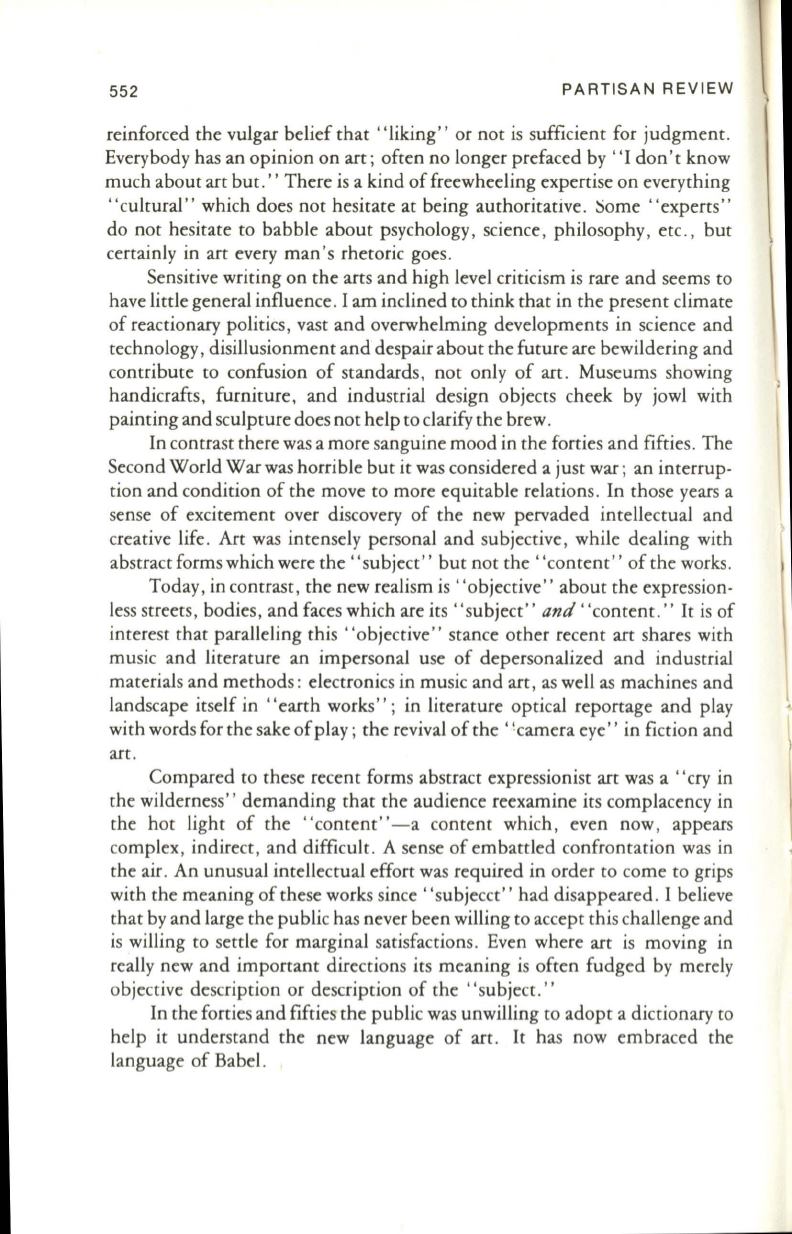
552
PARTISAN REVIEW
reinforced the vulgar belief that "liking" or not is sufficient for judgment.
Everybody has an opinion on art; often no longer prefaced by "I don't know
much about art but ." There is a kind of freewheeling expertise on everything
"cultural" which does not hesitate at being authoritative . Some "experts"
do not hesitate
to
babble about psychology, science , philosophy , etc., but
certainly in art every man 's rhetoric goes.
Sensitive writing on the arts and high level criticism is rare and seems to
have little general influence . I am inclined to think that in the present climate
of reactionary politics, vast and overwhelming developments in science and
technology, disillusionment and despair about the future are bewildering and
contribute to confusion of standards, not only of art. Museums showing
handicrafts, furniture, and industrial design objects cheek by jowl with
painting and sculpture does not help to clarify the brew.
In contrast there was a more sanguine mood in the forties and fifties . The
Second World War was horrible but it was considered a just war ; an interrup–
tion and condition of the move to more equitable relations . In those years a
sense of excitement over discovery of the new pervaded intellectual and
creative life . Art was intensely personal and subjective , while dealing with
abstract forms which were the' 'subject" but not the' 'content" of the works.
Today, in contrast, the new realism is " objective" about the expression–
less streets, bodies, and faces which are its "subject"
and
"content. "
It
is of
interest that paralleling this " objective" stance other recent
art
shares with
music and literature an impersonal use of depersonalized and industrial
materials and methods : electronics in music and art , as well as machines and
landscape itself in "earth works " ; in literature optical reportage and play
with words for the sake of play ; the revival of the
' ~camera
eye" in fiction and
art.
Compared to these recent forms abstract expressionist art was a " cry in
the wilderness" demanding that the audience reexamine its complacency in
the hot light of the " content" -a content which, even now, appears
complex, indirect, and difficult . A sense of embattled confrontation was in
the air. An unusual intellectual effort was required in order to come to grips
with the meaning of these works since' 'subjecct" had disappeared . I believe
that by and large the public has never been willing
to
accept this challenge and
is willing to settle for marginal satisfactions . Even where art is moving in
really new and important directions its meaning is often fudged by merely
objective description or description of the' 'subject ."
In the forties and fifties the public was unwilling to adopt a dictionary
to
help it understand the new language of art .
It
has now embraced the
language of Babel.
\


